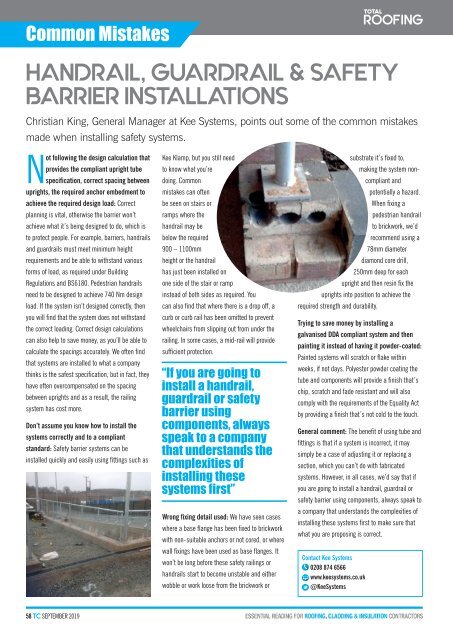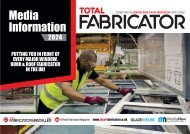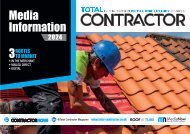September 2019
You also want an ePaper? Increase the reach of your titles
YUMPU automatically turns print PDFs into web optimized ePapers that Google loves.
Common Mistakes<br />
HANDRAIL, GUARDRAIL & SAFETY<br />
BARRIER INSTALLATIONS<br />
Christian King, General Manager at Kee Systems, points out some of the common mistakes<br />
made when installing safety systems.<br />
Not following the design calculation that<br />
provides the compliant upright tube<br />
specification, correct spacing between<br />
uprights, the required anchor embedment to<br />
achieve the required design load: Correct<br />
planning is vital, otherwise the barrier won’t<br />
achieve what it’s being designed to do, which is<br />
to protect people. For example, barriers, handrails<br />
and guardrails must meet minimum height<br />
requirements and be able to withstand various<br />
forms of load, as required under Building<br />
Regulations and BS6180. Pedestrian handrails<br />
need to be designed to achieve 740 Nm design<br />
load. If the system isn’t designed correctly, then<br />
you will find that the system does not withstand<br />
the correct loading. Correct design calculations<br />
can also help to save money, as you’ll be able to<br />
calculate the spacings accurately. We often find<br />
that systems are installed to what a company<br />
thinks is the safest specification, but in fact, they<br />
have often overcompensated on the spacing<br />
between uprights and as a result, the railing<br />
system has cost more.<br />
Don’t assume you know how to install the<br />
systems correctly and to a compliant<br />
standard: Safety barrier systems can be<br />
installed quickly and easily using fittings such as<br />
Kee Klamp, but you still need<br />
to know what you’re<br />
doing. Common<br />
mistakes can often<br />
be seen on stairs or<br />
ramps where the<br />
handrail may be<br />
below the required<br />
900 – 1100mm<br />
height or the handrail<br />
has just been installed on<br />
one side of the stair or ramp<br />
instead of both sides as required. You<br />
can also find that where there is a drop off, a<br />
curb or curb rail has been omitted to prevent<br />
wheelchairs from slipping out from under the<br />
railing. In some cases, a mid-rail will provide<br />
sufficient protection.<br />
“If you are going to<br />
install a handrail,<br />
guardrail or safety<br />
barrier using<br />
components, always<br />
speak to a company<br />
that understands the<br />
complexities of<br />
installing these<br />
systems first”<br />
Wrong fixing detail used: We have seen cases<br />
where a base flange has been fixed to brickwork<br />
with non-suitable anchors or not cored, or where<br />
wall fixings have been used as base flanges. It<br />
won’t be long before these safety railings or<br />
handrails start to become unstable and either<br />
wobble or work loose from the brickwork or<br />
substrate it’s fixed to,<br />
making the system noncompliant<br />
and<br />
potentially a hazard.<br />
When fixing a<br />
pedestrian handrail<br />
to brickwork, we’d<br />
recommend using a<br />
78mm diameter<br />
diamond core drill,<br />
250mm deep for each<br />
upright and then resin fix the<br />
uprights into position to achieve the<br />
required strength and durability.<br />
Trying to save money by installing a<br />
galvanised DDA compliant system and then<br />
painting it instead of having it powder-coated:<br />
Painted systems will scratch or flake within<br />
weeks, if not days. Polyester powder coating the<br />
tube and components will provide a finish that’s<br />
chip, scratch and fade resistant and will also<br />
comply with the requirements of the Equality Act<br />
by providing a finish that’s not cold to the touch.<br />
General comment: The benefit of using tube and<br />
fittings is that if a system is incorrect, it may<br />
simply be a case of adjusting it or replacing a<br />
section, which you can’t do with fabricated<br />
systems. However, in all cases, we’d say that if<br />
you are going to install a handrail, guardrail or<br />
safety barrier using components, always speak to<br />
a company that understands the complexities of<br />
installing these systems first to make sure that<br />
what you are proposing is correct.<br />
Contact Kee Systems<br />
0208 874 6566<br />
www.keesystems.co.uk<br />
@KeeSystems<br />
58 TC SEPTEMBER <strong>2019</strong>

















